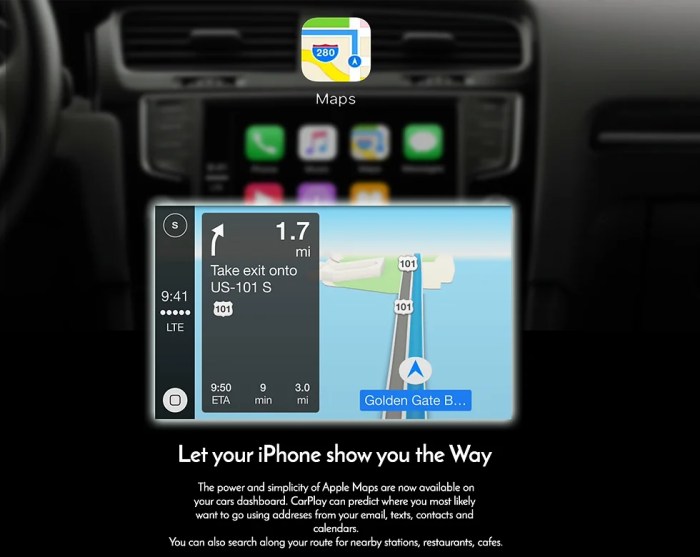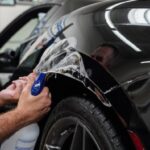How to retrofit Apple CarPlay in older SUVs? That’s the question we’re tackling today! Giving your aging ride a serious tech upgrade is totally doable, even if you’re not a car whiz. We’ll walk you through everything from checking compatibility and picking the right kit to tackling the installation yourself (or finding a pro). Get ready to ditch that outdated infotainment system and enjoy the seamless integration of your iPhone on the road.
This guide covers everything you need to know, from identifying compatible SUVs and choosing the right installation method to troubleshooting common issues and customizing your CarPlay setup. We’ll break down the process into manageable steps, complete with helpful tips and tricks to make the whole experience as smooth as possible. Whether you’re a seasoned DIYer or prefer to leave it to the professionals, we’ve got you covered.
Determining Compatibility
Adding Apple CarPlay to your older SUV can be a seriously awesome upgrade, but it’s not a one-size-fits-all situation. Before you dive into the installation, you need to figure out if your ride is even compatible and how much of a headache the process might be. This section will help you navigate the compatibility landscape and choose the right aftermarket CarPlay kit for your specific SUV.Knowing your SUV’s make, model, and year is crucial.
Certain model years and trim levels are more easily retrofitted than others due to variations in the existing infotainment systems and available wiring harnesses. Some older models might require more extensive modifications, while others offer relatively straightforward plug-and-play solutions. The level of difficulty can significantly impact the overall cost and time investment.
SUV Compatibility and Installation Complexity
Compatibility depends heavily on your SUV’s infotainment system. Generally, SUVs manufactured from around 2015 onward are more likely to have simpler installations, often involving connecting to the existing screen using an interface module. Older models, however, might necessitate more extensive wiring and potentially even custom fabrication. For example, a 2018 Honda CR-V might have a relatively straightforward installation, while a 2008 Toyota Highlander might require significantly more work, potentially even involving replacing the entire head unit.
A 2012 Ford Explorer might fall somewhere in between, depending on the specific trim level and factory options. The availability of pre-existing wiring harnesses for your specific model year will also influence the installation complexity.
Aftermarket CarPlay Integration Kit Comparison
Choosing the right kit is key. Here’s a comparison of a few popular options, keeping in mind that prices and availability can fluctuate:
| Kit Name | Features | Compatibility | Approximate Price (USD) |
|---|---|---|---|
| Example Kit A | Wireless CarPlay, Android Auto, Backup Camera Input | Wide range of vehicles, check manufacturer’s website for specifics | $200 – $300 |
| Example Kit B | Wired CarPlay, Steering Wheel Controls Integration | Limited compatibility, primarily for specific models and years | $150 – $250 |
| Example Kit C | Wireless CarPlay, Android Auto, HD Screen Mirroring | Broad compatibility, but installation might require professional help for some vehicles | $300 – $400 |
| Example Kit D | Wired CarPlay, simpler installation | Focuses on specific makes and models, check compatibility before purchase | $100 – $180 |
Note: The prices listed are estimates and can vary based on retailer and sales. Always check the manufacturer’s website for the most up-to-date compatibility information and pricing. The features listed are examples and might not represent all features offered by each kit. Thoroughly research each kit before purchasing to ensure it meets your needs and is compatible with your specific SUV model and year.
Choosing an Installation Method
Adding Apple CarPlay to your older SUV is a game-changer, but the installation process itself can be a bit of a wild ride. Choosing between a professional install and a DIY project depends heavily on your comfort level with car electronics and your available time. Let’s break down the pros and cons to help you decide.Professional installation offers peace of mind and ensures the job is done right, minimizing the risk of damaging your vehicle’s electrical system.
DIY, on the other hand, can save you some serious cash, but requires patience, attention to detail, and a willingness to potentially troubleshoot problems.
Professional vs. DIY Installation
Professional installation is the safer bet if you’re not comfortable working with car electronics or lack the necessary tools. A pro has the experience to diagnose any potential issues quickly and efficiently, ensuring a seamless integration. For example, if your SUV has a complex wiring harness or a finicky infotainment system, a professional installer can navigate those complexities without causing damage.
The downside? It’s more expensive. DIY installation, however, is perfect for the mechanically inclined who enjoy a good challenge. If you’re comfortable with basic car repairs and have the patience to follow instructions carefully, you can save a significant amount of money. Consider a DIY approach if you’re upgrading a simpler system in a vehicle with easy access to the radio and wiring.
However, if something goes wrong, you’ll be responsible for fixing it.
Tools and Materials for Installation
The tools and materials needed vary depending on the installation method (professional or DIY) and the type of CarPlay kit.
Professional Installation: Professionals typically have access to a wider array of specialized tools and diagnostic equipment. They’ll likely use a combination of tools including:
- Specialized wiring harnesses and connectors
- Diagnostic scanners to avoid electrical issues
- Specialized tools for removing and installing car components
- High-quality soldering equipment (if needed)
- Various hand tools such as screwdrivers, pliers, and wire strippers
DIY Installation: For a DIY approach, you’ll need a more basic, but still comprehensive, set of tools:
- A detailed installation guide (provided with the CarPlay kit)
- A set of screwdrivers (Phillips and flathead)
- Wire strippers and crimpers
- Electrical tape
- Possibly a multimeter for testing electrical connections
Aftermarket CarPlay Integration Kits
There are several types of aftermarket CarPlay integration kits available, each with its own set of advantages and disadvantages.
Plug-and-Play Kits: These are the easiest to install and generally require minimal technical expertise. They typically involve connecting a small device to your existing infotainment system via USB or other interface. However, they might not offer the same level of integration as other options, and their functionality may be limited. For example, you might not get full screen mirroring or access to all of your car’s features.
Integrated Units: These units replace your entire existing head unit, offering a more complete and seamless integration with Apple CarPlay. They usually offer better performance, more features, and a more modern look. Installation is more complex, however, requiring more technical skills and potentially more time. An example would be a complete Android Auto/Apple CarPlay replacement unit with a larger touchscreen than the factory-installed system.
Step-by-Step Installation Guide (DIY): How To Retrofit Apple CarPlay In Older SUVs
Retrofitting Apple CarPlay into your older SUV can seem daunting, but with careful planning and execution, it’s a manageable DIY project. This guide provides a detailed walkthrough, assuming you’ve already determined compatibility and chosen your installation method (e.g., using an aftermarket head unit or an interface). Remember to always consult your vehicle’s manual and the instructions provided with your chosen CarPlay kit.
Safety first! Disconnect your vehicle’s battery negative terminal before starting any electrical work.
Preparing the Vehicle
Before beginning the physical installation, it’s crucial to prepare your vehicle. This involves gathering the necessary tools, ensuring you have adequate workspace, and disconnecting the vehicle’s battery. Having all your tools readily available will streamline the process and prevent unnecessary delays. A well-lit workspace is also essential for precise work. Disconnecting the battery is a crucial safety precaution to prevent accidental short circuits and damage to your vehicle’s electrical system.
Gather your tools (screwdrivers, trim removal tools, wire strippers, etc.), find a well-lit workspace, and disconnect the negative battery terminal.
Installing the CarPlay Interface or Head Unit
This step varies greatly depending on the chosen method. For an aftermarket head unit, this will involve removing the factory radio, installing the new unit, and connecting the necessary wiring harnesses. For an interface, this typically involves connecting the interface to the back of your factory radio and routing the necessary cables. Detailed instructions will be included with your specific kit.
Remember to carefully follow those instructions. For example, when connecting the wiring harness for an aftermarket head unit, ensure that all the wires are correctly matched and securely connected to avoid any electrical issues. Incorrect wiring could damage your vehicle’s electrical system or the new head unit itself. When installing an interface, pay close attention to the ground wire connection to ensure a stable and reliable signal.
Routing Cables and Connecting the Power Source
Once the interface or head unit is installed, carefully route the necessary cables. This often involves running cables behind the dashboard and along existing wiring harnesses. Secure the cables using zip ties or cable clips to prevent them from dangling or becoming damaged. Connecting the power source is critical; ensure that you connect the power and ground wires to the correct locations.
So you’re trying to figure out how to retrofit Apple CarPlay into your grandpa’s old SUV? It’s a total pain, right? Completely different than upgrading something straightforward, like, say, getting towing mirrors for Ford Super Duty trucks – those are usually a pretty simple bolt-on. Anyway, back to CarPlay – have you checked out any online forums for your specific SUV model?
They’re usually a goldmine of info.
Incorrect connections can lead to malfunctions or even damage. Consult your wiring diagram and the instructions provided with your kit to ensure you connect the power and ground wires correctly. For instance, improperly grounding the system can result in intermittent functionality or noise in your audio system.
Testing and Finalizing the Installation
After completing the installation, reconnect the vehicle’s battery. Turn on the ignition and test the Apple CarPlay functionality. Check all features, including music playback, navigation, and phone calls. If everything works as expected, carefully reassemble any removed panels and trim pieces. If you encounter any issues, refer to the troubleshooting section below.
For example, if the CarPlay screen is unresponsive, check all cable connections and ensure the power source is properly connected.
Flowchart: Apple CarPlay Retrofit Installation
[Image Description: A flowchart would be included here. The flowchart would begin with “Prepare the Vehicle” and branch to “Gather Tools,” “Find Workspace,” and “Disconnect Battery.” The next step would be “Install Interface/Head Unit” branching to “Install Aftermarket Head Unit” and “Install Interface.” Each of these would have further sub-steps (not explicitly shown in the image description). The next step would be “Route Cables and Connect Power,” followed by “Test and Finalize Installation.” The final box would be “Complete.”]
Troubleshooting Common Installation Problems
| Problem | Possible Cause | Solution | Additional Notes |
|---|---|---|---|
| CarPlay not working | Incorrect wiring | Double-check all wiring connections | Consult wiring diagrams and installation instructions. |
| Intermittent CarPlay connection | Loose connections or faulty cable | Inspect all connections and replace any damaged cables | Pay close attention to the ground wire connection. |
| Audio issues | Incorrect audio settings or faulty speakers | Check audio settings on both the head unit and iPhone. Inspect speakers | Ensure proper speaker wiring. |
| Screen display issues | Faulty display or incorrect video settings | Check the display for any physical damage. Adjust video settings. | Ensure compatibility between the head unit and the display. |
Post-Installation Checks and Considerations

Successfully installing Apple CarPlay in your older SUV is only half the battle. A thorough post-installation check ensures everything works smoothly and, more importantly, safely. Skipping this crucial step could lead to frustrating malfunctions or, worse, potential electrical hazards. Let’s make sure your upgrade is a success!Post-installation checks are critical for verifying proper functionality and addressing potential issues before they become major problems.
This involves more than just confirming CarPlay is working; it includes evaluating the entire system’s integration and stability. Neglecting these checks can lead to anything from intermittent glitches to significant electrical damage.
CarPlay Functionality and Integration
After the installation, the first step is to verify that CarPlay is functioning correctly. This includes checking for seamless connectivity with your iPhone, accurate audio playback, and responsiveness of the touchscreen or control interface. If the system is sluggish or unresponsive, there might be a problem with the wiring or the CarPlay interface itself. For example, if the screen displays only a partial image or the audio cuts out intermittently, re-checking all connections, especially the grounding wire, is crucial.
So you’re trying to figure out how to retrofit Apple CarPlay into your grandpa’s old SUV? It’s a total pain, but way easier than trying to pick the right aftermarket parts – like, seriously, have you seen the options for Top-rated rock sliders for Jeep Gladiator ? That’s a whole other level of car modification. Anyway, back to CarPlay; plenty of online guides can walk you through the process, just be prepared for some serious wiring.
A poorly seated connector or a loose wire can cause significant performance issues. Another common issue is a conflict between the CarPlay system and the vehicle’s existing infotainment system. This might manifest as audio dropouts or screen flickering. Resolving this usually involves carefully adjusting the settings on both systems to avoid signal interference.
Grounding and Wiring Connections
Proper grounding is paramount. A poorly grounded system can lead to all sorts of electrical gremlins, from intermittent CarPlay malfunctions to blown fuses, and even damage to your car’s electrical system. Imagine a scenario where the grounding wire is connected to a rusty bolt, creating a high-resistance connection. This can cause erratic behavior in the CarPlay system, leading to unexpected shutdowns or even short circuits.
Always ensure a clean, solid ground connection to a designated grounding point on your vehicle’s chassis. Similarly, all wiring connections should be secure and properly insulated. Loose connections can cause intermittent failures, while exposed wires present a significant safety hazard. For example, a bare wire rubbing against a metal part of the car could lead to a short circuit, potentially causing a fire.
Use appropriately sized wire, ensuring proper insulation and securing all connections with appropriate connectors and electrical tape. A visual inspection of all connections, both before and after the insulation, is recommended.
Integration with Existing Car Audio Systems
Integrating CarPlay with your existing car audio system can present unique challenges. Depending on your car’s model and the type of aftermarket CarPlay system you installed, you might encounter compatibility issues. For instance, if your car’s factory system uses a specific audio protocol that’s not fully compatible with the CarPlay unit, you might experience audio dropouts or distortion.
Troubleshooting these issues often involves adjusting the audio settings on both the CarPlay unit and the factory system, ensuring they’re properly configured to work together. In some cases, professional installation might be necessary to handle complex integration tasks, particularly if the vehicle has an advanced audio system. The integration process might also involve adjusting the equalizer settings or routing audio signals through different channels to achieve optimal sound quality.
Advanced Features and Customization
After successfully retrofitting Apple CarPlay into your older SUV, you’re likely eager to explore its full potential. This section delves into customizing your CarPlay experience and adding advanced features to truly personalize your in-car entertainment and navigation. We’ll cover tweaking settings, exploring potential wireless upgrades, and comparing different interface options.Customizing CarPlay settings involves a surprisingly deep dive into personal preferences.
You can adjust everything from the display brightness and volume to the notification preferences and app layout. This level of customization ensures that your CarPlay setup perfectly complements your driving style and technological comfort zone.
CarPlay Settings and Preferences
Accessing and modifying your CarPlay settings is generally straightforward. On most systems, you’ll find a settings menu directly within the CarPlay interface itself, usually accessed through an icon resembling a gear or cogwheel. Within this menu, you can manage a variety of options. For example, you can adjust the appearance of the interface, choosing between light and dark modes to suit your driving environment and personal preference.
You can also choose which apps appear on your home screen, rearrange their order, and even choose to disable certain notifications if they prove distracting while driving. The specific options available will vary slightly depending on your head unit and the version of iOS running on your iPhone. Think of it as fine-tuning your dashboard to your exact specifications.
Wireless CarPlay Integration
Many aftermarket CarPlay retrofit kits offer the option to upgrade to wireless CarPlay. This eliminates the need for a physical connection between your iPhone and the head unit, providing a more streamlined and convenient user experience. However, it’s important to note that wireless CarPlay typically requires a separate adapter or module that interfaces with your retrofit kit. The performance of wireless CarPlay can sometimes be slightly less stable than wired CarPlay, with potential for occasional dropouts or latency.
The benefit of wireless convenience often outweighs these minor drawbacks for many users, but the choice depends on individual priorities and tolerance for potential connectivity issues. A successful wireless integration means a cleaner dashboard and less cable clutter.
Comparison of CarPlay Interfaces
The quality and features of CarPlay interfaces vary significantly depending on the specific retrofit kit chosen. Some kits offer higher-resolution displays, providing sharper graphics and more detailed maps. Others may include additional features like enhanced voice control or integration with other vehicle systems. For example, a higher-end kit might offer a faster processor leading to quicker app launch times and smoother overall performance, while a more basic kit might have a simpler interface with fewer customizable options.
Consider factors like screen size, resolution, processing speed, and additional features when choosing a kit, as these directly impact the overall user experience. Ultimately, the best interface for you depends on your budget and desired level of sophistication.
Cost Breakdown and Budgeting

Retrofitting Apple CarPlay into your older SUV can be a worthwhile upgrade, but it’s crucial to understand the costs involved before you begin. This section provides a detailed breakdown to help you budget effectively for your project. Accurate budgeting will prevent unpleasant surprises and ensure a smooth installation process.This section details the various costs associated with a CarPlay retrofit, helping you create a realistic budget and compare DIY versus professional installation.
We’ll cover the cost of the interface kit, potential installation fees, and additional materials you might need. We’ll also look at how much time each approach might take.
Cost of the CarPlay Interface Kit
The price of the CarPlay interface kit varies significantly depending on the make and model of your SUV and the features offered. A basic kit might cost between $100 and $300, while more advanced kits with extra features like improved audio processing or integration with other vehicle systems can cost upwards of $500. Factors influencing price include brand reputation, additional features (like wireless CarPlay), and compatibility with your specific vehicle’s infotainment system.
For example, a kit designed for a simpler system in a Honda CRV might cost less than one designed for a more complex system in a Land Rover Discovery.
Installation Costs, How to retrofit Apple CarPlay in older SUVs
The cost of installation is another major factor. A DIY installation can save you money, but requires time and technical skills. Professional installation, on the other hand, is more expensive but guarantees a clean and properly functioning system. Professional installation fees can range from $100 to $300 or more, depending on the complexity of the installation and the shop’s location and labor rates.
Some shops might charge an hourly rate, while others might offer a flat fee.
Additional Materials and Potential Expenses
Beyond the kit and installation, you might need additional materials. These could include specialized tools (like trim removal tools), wiring harnesses, or adapters. These can add another $20 to $100 to your total cost. Remember to factor in potential unforeseen expenses. For example, you might discover a damaged wire during installation, requiring a replacement.
Sample Budget
It’s important to create a comprehensive budget before starting the project. Here’s a sample budget, keeping in mind that these figures are estimates and can vary depending on your specific situation:
- CarPlay Interface Kit: $250
- Professional Installation (or DIY time equivalent): $150
- Additional Materials: $50
- Unforeseen Expenses (buffer): $50
- Total Estimated Cost: $500
This budget assumes a mid-range CarPlay interface kit and professional installation. A DIY approach could significantly reduce the total cost, but increases the time commitment.
DIY vs. Professional Installation: A Comparison
The choice between DIY and professional installation comes down to your skills, time, and comfort level.
| Factor | DIY Installation | Professional Installation |
|---|---|---|
| Cost | Lower initial cost | Higher initial cost |
| Time | Significantly more time | Less time |
| Skill Level | Requires technical skills and patience | No technical skills required |
| Warranty | Warranty may be affected by DIY installation | Warranty typically covered |
| Risk of Damage | Higher risk of damaging vehicle components | Lower risk of damage |
Ultimately, the best option depends on your individual circumstances. If you’re comfortable working with electronics and have the time, a DIY approach can save you money. However, if you value convenience, peace of mind, and a guaranteed professional installation, then paying for professional services might be the better choice.
Final Conclusion
So, there you have it – a comprehensive guide to bringing the convenience and connectivity of Apple CarPlay to your older SUV. Whether you choose a DIY approach or opt for professional installation, the result is a significant upgrade to your driving experience. Remember to carefully consider compatibility, choose the right kit, and follow the steps meticulously. With a little patience and the right tools, you can enjoy the seamless integration of your iPhone, transforming your daily commute into a more connected and enjoyable experience.
Happy driving!









